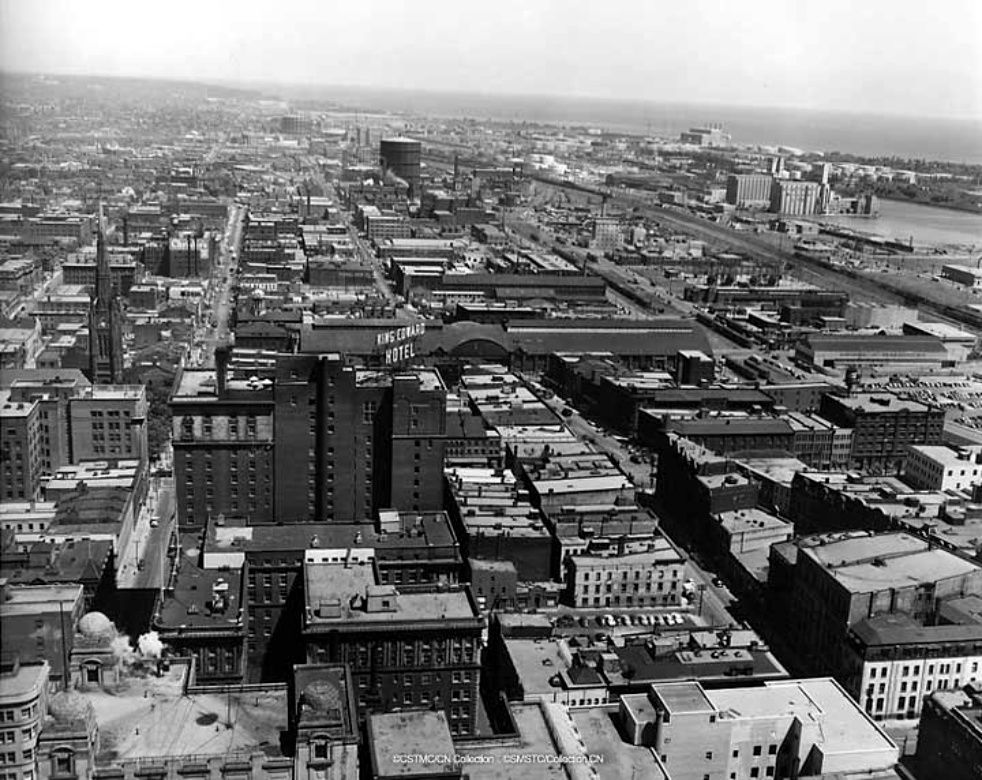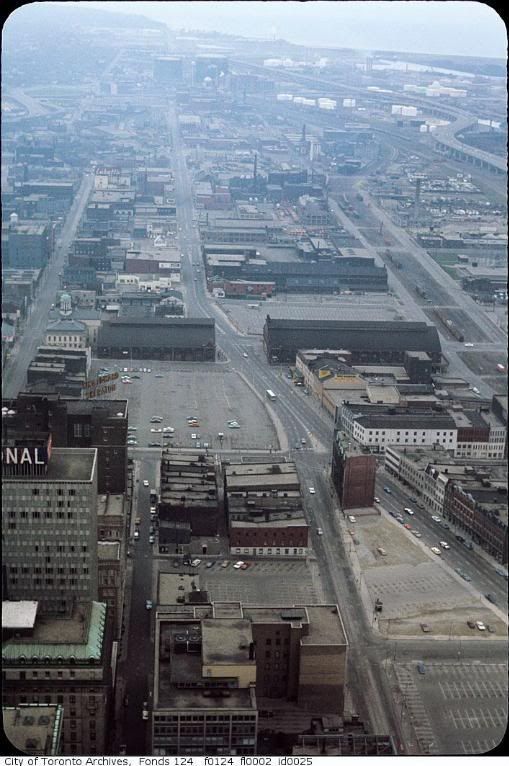Those 2 narrow north facing blank walls are perfect for backlit ads or billboards facing Dundas Square. Ads on various surrounding buildings including on top of 277 Victoria Street (NE corner of Square) would go a long way to further creating more of that intimate big city times square type feeling.
In that vein, it's funny how what was once derided on UT is that which now some see as an asset:
Brilliant .gif c/o MetroMan circa 2008
I mentioned this a while back but I still think that this project (and all of Dundas Square's surrounding buildings) should be clad with ads. This is the right place for this sort of in-your face urbanism/commercialism. Although Times Square is a totally different beast, a glimpse at how profitable building ads have become:
Ads, Not Tenants, Make Times $quare (Eliot Brown, Wall Street Journal)
http://online.wsj.com/article/SB10001424127887323476304578199310470733342.html
Ads, Not Tenants, Make Times $quare By ELIOT BROWN
When the Times Square ball drops New Year's Eve to ring in 2013, it will do so over a Manhattan office building that is mostly empty.
Yet, it is minting cash.
The 25-story tower is doing a booming business as a billboard, its exterior cloaked with advertisements that can be seen each year by hundreds of millions of television viewers and passersby.
Documents connected to a recent refinancing of the building give a glimpse into the lucrative trade of owning sign space in Times Square, which has boomed as the count of tourists and office workers in the once-seedy neighborhood has swelled.
From sign rentals alone, the small trapezoidal building at One Times Square takes in more than $23 million a year in revenue, the documents say.
For example, Dunkin' Brands Group Inc. pays $3.6 million a year for a Dunkin' Donuts digital sign that often shows photos of fans who send images to the company's Facebook FB -0.82% page. Anheuser-Busch InBev pays $3.4 million a year for a sign that shows close-ups of icy bottles of Budweiser and other brands.
Other companies with signs include Sony Corp. 6758.TO +1.46% and News America, which share a sign that costs $4 million a year. News Corp NWSA -1.32% . owns News America and Dow Jones & Co., publisher of The Wall Street Journal, which also rents sign space on the building.
Along with rents from a Walgreen Co. WAG -0.71% store on the bottom three floors, those sums give the otherwise empty building an appraised value of $495 million, according to the loan documents. That is more than twice the sale price fetched this spring by 222 Broadway, a 31-story Lower Manhattan office building that is home to Bank of America Corp. BAC -0.58% employees and has more than six times the square footage as One Times Square.
"We've been very happy with it," said Michael Phillips, chief operating officer at Jamestown Properties, an Atlanta-based landlord that bought One Times Square through a fund in 1997 for $117 million.
Jamestown's success in turning One Times Square into a cash machine reflects the rising value of advertising in one of the country's iconic tourist destinations. More than 100 million pedestrians pass through the area a year, according to Times Square Alliance, a nonprofit business improvement organization. Foot traffic at key intersections is up about 90% since 1996, the Alliance estimates.
Property owners in Times Square area say the rates for their signs are roughly double what they were a decade ago, although they vary widely by location. That is due in part to rising tourism to New York City—now at a record 50.9 million visitors annually.
Another factor: More owners have converted to digital billboards. Such signs are more expensive to build but can rent for five or six times as much as a static vinyl sign, according to Standard & Poor's Ratings Service, which rated One Times Square's mortgage.
Advertising-industry executives say Times Square has the highest-price outdoor signage in the world, above tourist-filled squares such as Piccadilly Circus in London. The pace of growth is well ahead of the advertising market for billboards nationally, which has seen modest growth of 3% to 4% a year, according to Matthew Chelser, an analyst at Deutsche Bank DBK.XE +1.10% AG.
Small-market billboards typically rent for $1,000 to $2,000 a month, he said.
The signage in the area was once something of an afterthought for landlords. But these days, landlords are racing to put ever-larger signs on their buildings in a bid to get the $2 million to $4 million a year, or more, such signs can bring.
Vornado Realty Trust VNO +0.48% has said it is planning a sprawling new digital sign display on the 300-foot-long base of the Marriott Marquis hotel on 46th Street and Broadway. New York developer Steve Witkoff and his partners have said they view signage as a significant profit driver in their plans to raze an office building and build a retail development on 47th Street and Seventh Avenue.
At an investor conference earlier this month, Edward Piccinich, executive vice president at SL Green Realty Corp., SLG -0.34% described the company's planned giant digital signage in Times Square as the "magnum opus" of a new development that is set to hold a flagship store for clothing retailer Express Inc., EXPR +1.37% which is also leasing the sign.
Express, in turn, could make money leasing out the sign part of the time to advertisers. "Those signs are worth a fortune," Michael Weiss, Express's chief executive, said at an investor conference earlier this year, according to a transcript. "I mean, they cost you a fortune, but they're worth a fortune."
Of course, the advertising business can be rocky. General Motors Co. GM +2.37% gave up a big sign on One Times Square, along with other leased real estate, following its 2009 bankruptcy filing. The auto maker's sign was replaced by Dunkin' Donuts.
For One Times Square, the times weren't always so great. At one point, planners called, unsuccessfully, for the building, built in 1904, to be torn down as part of a larger area redevelopment. But the district has blossomed over the past two decades, thanks in part to a state-led effort that promoted new development, and One Times Square's value gradually grew.
"That's the one that got away in my life," said Lawrence Linksman, who sold the property in the early 1980s for about $10 million after what he says was an ownership dispute. He said he avoids the area these days because the memory is painful.
Jamestown bought the building 15 years ago with New York-based Sherwood Equities, its partner at the time. This fall, Jamestown refinanced to get a $208 million mortgage from Goldman Sachs Group Inc. GS -0.55% on the tower, which was sold off to bond investors earlier this month in the form of commercial-mortgage-backed securities.
The advertisers who take space in the tower say the prices are high, but the visibility is unparalleled.
"There's a statement we make in being there—and we think the placement we've got is outstanding," said Blaise D'Sylva, a vice president for marketing at Anheuser-Busch.
Still, for others, the cost has gotten too dear. Nissin Food Products Co., 2897.TO +1.68% which used to have a picture of a giant Japanese-style ramen noodle cup on One Times Square, didn't renew when its lease expired a few years ago.
"We had to sell a lot of ramen before the billboard paid for itself," said Linda Chung, assistant vice president of marketing at Nissin.
Others question whether the increase in signs throughout the area—more than 230 now—will dilute the value of existing signs.
"You've probably overcooked it over there," says Neill Macklin, who oversees signage for landlord Land Securities Group LAND.LN -0.24% PLC at Piccadilly Circus.

Uploaded with
ImageShack.us



